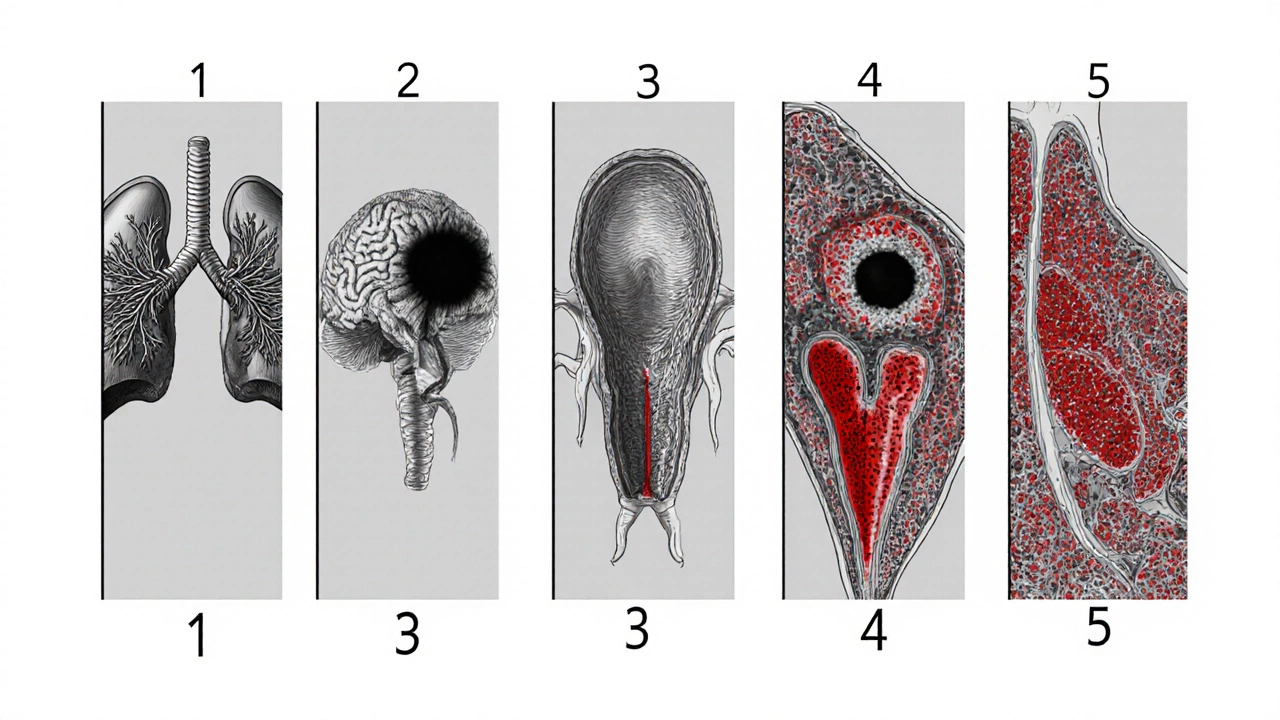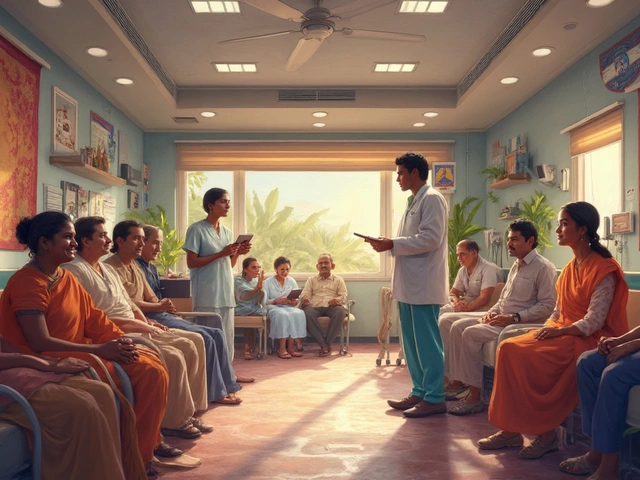
Cancer Survival Rate Comparison Tool
This interactive tool helps visualize the survival rates of cancers with the lowest survival statistics. The 5-year survival rate represents the percentage of patients alive five years after diagnosis.
Pancreatic Cancer
5-year survival rate: 9%
Typical stage at diagnosis: Stage III-IV
Mesothelioma
5-year survival rate: 10%
Typical stage at diagnosis: Stage III-IV
Small-cell Lung Cancer
5-year survival rate: 6%
Typical stage at diagnosis: Stage III-IV
Glioblastoma
5-year survival rate: <5%
Typical stage at diagnosis: Stage IV
Key Facts About Low Survival Cancers
- Pancreatic Cancer: Often diagnosed at advanced stages due to lack of early symptoms
- Mesothelioma: Strong association with asbestos exposure
- Small-cell Lung Cancer: Aggressive cancer that spreads rapidly
- Glioblastoma: Most aggressive primary brain tumor in adults
Note: Survival rates are statistical averages from large population studies and do not predict an individual's outcome. Factors such as age, overall health, and treatment response significantly influence prognosis.
When you hear "lowest cancer survival rate", the first name that usually pops up is pancreatic cancer. It’s the cancer that most people hear about as the toughest to beat, and the numbers back that up. Below we break down why that cancer, plus a few others, sit at the bottom of the survival charts, what the stats really mean, and what you can do if you or a loved one face a diagnosis.
Understanding Survival Rates
Survival rates are usually reported as a "5‑year survival rate" - the percentage of patients alive five years after diagnosis. It’s a standard benchmark because many cancers behave differently after that point, and five years gives doctors a clear window to assess treatment effectiveness.
The rate is calculated from large population studies, so it reflects average outcomes, not an individual’s fate. Factors like age, overall health, and how early the cancer is caught can shift the odds dramatically.
Pancreatic Cancer: The Toughest Stats
Pancreatic Cancer is a malignant tumor that forms in the tissues of the pancreas, an organ that produces enzymes and hormones that help digest food and regulate blood sugar is often called the deadliest major cancer. According to the latest global cancer registry (2024 data), the 5‑year survival rate hovers around 9% worldwide.
Why is it so grim? The pancreas sits deep in the abdomen, so early tumors don’t cause noticeable symptoms. By the time pain, weight loss, or jaundice appear, the disease is usually already stage III or IV - meaning it has spread beyond the pancreas.
Even with surgery, which is only an option for about 15‑20% of patients, the chance of a cure is low because microscopic cancer cells often linger. Chemotherapy and newer targeted therapies have nudged survival up a few points, but the gap remains wide.
Other Cancers with Very Low Survival
While pancreatic cancer tops the list, a handful of other cancers also sit near the bottom.
- Mesothelioma is a rare cancer that develops in the thin membrane surrounding the lungs or abdomen, most often linked to asbestos exposure - 5‑year survival roughly 10%.
- Lung Cancer (Small‑cell) is an aggressive form of lung cancer that spreads quickly - survival about 6% for extensive‐stage disease.
- Glioblastoma is the most common and aggressive primary brain tumor in adults - median survival 15 months; 5‑year rate under 5%.
- Ovarian Cancer (advanced stage) often presents late with abdominal swelling and pain - 5‑year survival around 30% for stage III‑IV.
- Acute Myeloid Leukemia (elderly) is a fast‑growing blood cancer more common in adults over 60 - 5‑year survival under 15%.

Comparison Table: Survival Stats at a Glance
| Cancer Type | 5‑Year Survival Rate | Typical Stage at Diagnosis | Common Early Symptoms |
|---|---|---|---|
| Pancreatic Cancer | ~9% | Stage III‑IV | Jaundice, unexplained weight loss, abdominal pain |
| Mesothelioma | ~10% | Stage III‑IV | Chest pain, shortness of breath, persistent cough |
| Small‑cell Lung Cancer | ~6% (extensive stage) | Stage III‑IV | Persistent cough, chest heaviness, weight loss |
| Glioblastoma | <5% | Stage IV (by definition) | Headaches, seizures, vision changes |
| Advanced Ovarian Cancer | ~30% (stage III‑IV) | Stage III‑IV | Abdominal bloating, pelvic pain |
| Acute Myeloid Leukemia (≥60 yrs) | <15% | Often advanced | Fatigue, easy bruising, infections |
Why Survival Is So Low - Key Factors
Three main reasons push these cancers into the low‑survival zone:
- Late Detection: Symptoms mimic benign conditions, so patients and doctors often overlook warning signs.
- Biology of the Tumor: Some cancers grow fast, invade surrounding tissue, and resist standard chemo or radiation. Glioblastoma, for example, spreads microscopically throughout the brain within weeks.
- Limited Treatment Options: Surgical removal is rarely feasible for mesothelioma or pancreatic cancer because of location, and targeted drugs are still in early trials.
Interpreting the Numbers - What 5‑Year Survival Means
Seeing a 5‑year survival of 9% can feel hopeless, but it’s a statistical average. A small subgroup - usually younger patients with a resectable tumor - can beat the odds. For pancreatic cancer, patients under 55 who undergo a Whipple procedure (pancreaticoduodenectomy) plus adjuvant chemotherapy see 5‑year survival climb to about 30%.
Conversely, older patients with comorbidities may have a far lower chance, sometimes under 5%. That’s why doctors stress personalized treatment plans rather than relying solely on headline numbers.

How Early Detection Improves Odds
When researchers catch these cancers early, the survival curves start to rise. Screening programs for high‑risk groups (like smokers for lung cancer or individuals with a family history of pancreatic cancer) have shown promising results.
- Low‑Dose CT scans for heavy smokers can spot lung tumors when they’re still <2cm, boosting 5‑year survival to 20‑25% versus 5% with symptoms alone.
- Endoscopic Ultrasound (EUS) paired with fine‑needle aspiration can detect pancreatic lesions in high‑risk families, allowing surgery before spread.
- Blood‑based biomarkers like CA‑19‑9 for pancreatic cancer or circulating tumor DNA are under study and may become routine screening tools within the next few years.
Checklist for High‑Risk Individuals
If you or a family member fit any of the following profiles, talk to your doctor about targeted screening.
- Current or former heavy smoker (30+ pack‑years) - consider annual low‑dose CT.
- Family history of pancreatic, ovarian, or colorectal cancer - discuss genetic counseling and possible EUS.
- Previous exposure to asbestos (construction, shipbuilding, insulation) - ask about mesothelioma screening trials.
- Persistent, unexplained headaches or vision changes - early neuro‑imaging can catch brain tumors before functional loss.
- Age over 60 with unexplained fatigue, bruising, or frequent infections - a full blood count might reveal early leukemia.
Early detection doesn’t guarantee cure, but it dramatically widens the toolbox of treatment options and improves quality of life.
Frequently Asked Questions
What is the overall 5‑year survival rate for cancer?
Across all cancer types, the global 5‑year survival rate sits around 67% for high‑income countries, but it drops to about 45% in lower‑income regions due to access and early‑diagnosis gaps.
Why is pancreatic cancer harder to detect than breast cancer?
The pancreas is deep inside the abdomen, so tumors don’t cause outward lumps or skin changes. Breast tissue is superficial, making self‑exams and mammograms effective for early spotting.
Can lifestyle changes lower the risk of low‑survival cancers?
Yes. Quitting smoking cuts lung and pancreatic cancer risk dramatically. Maintaining a healthy weight and limiting alcohol reduces pancreatic and liver cancer chances. Avoiding asbestos exposure is critical for mesothelioma.
Are there any new treatments showing promise for pancreatic cancer?
Immunotherapy combos and PARP inhibitors for patients with BRCA mutations have extended survival in clinical trials. Researchers are also testing vaccine‑based approaches that aim to train the immune system to recognize tumor antigens.
How accurate are blood tests like CA‑19‑9 for early pancreatic cancer?
CA‑19‑9 is useful for monitoring treatment response, but its sensitivity for early detection is limited (around 70%). Elevated levels can also appear in non‑cancerous conditions, so it’s not a stand‑alone screening tool yet.
What support resources exist for patients with low‑survival cancers?
National cancer societies, online support groups, and palliative‑care teams provide emotional, logistical, and medical assistance. Early referral to a multidisciplinary team improves symptom management and can extend survival modestly.





